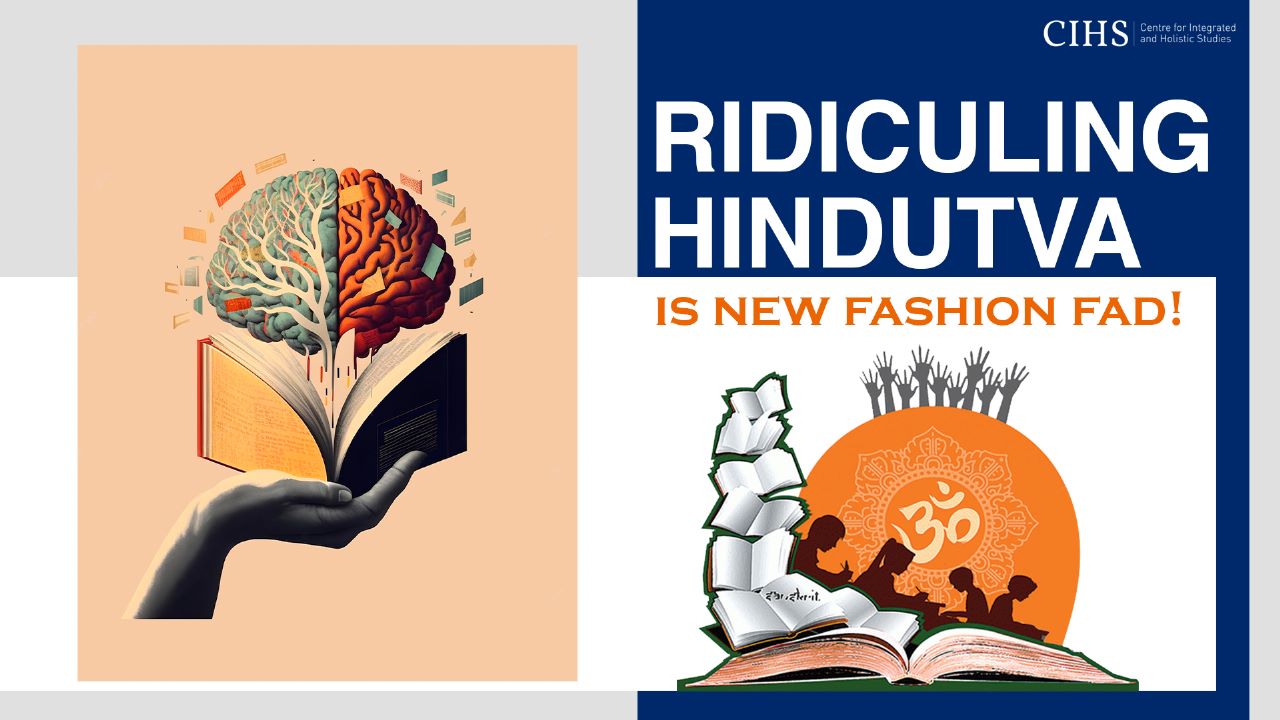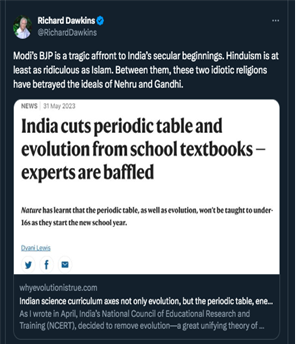
Ridiculing Hindutva is new fashion fad!
Textbooks revision in sync with new education policy, India’s contribution to science & technology must be taught.
Prachi Mishra
From magazines like Scientific American, Nature to British evolutionary biologist extraordinaire Richard Dawkins, many in global community seems to have been needlessly worked up about revision in syllabi for school going students in India.

Dawkins, who is renowned for his work, The Selfish Gene, took to twitter and bashed Indian government for removing the periodic table from Chemistry lessons and Darwin’s Theory of Evolution in other Science classes.
In his tweet, Dawkins made an inapposite remark, stating that “Hinduism is at least as ridiculous as Islam” attributing the revisions in text books that happen periodically to Hinduism. While the tweet was not only condescending, it was baseless and irrational. In the process, Dawkins joined some media houses globally that have made it their stated policy of intolerance towards ‘Hindus’ spread over 100 countries.
First, revision or restructuring school syllabi has nothing to do with Hindu dharma. Secondly, both Mahatma Gandhi and Jawaharlal Nehru were practising Hindus and did not deny their religious beliefs or practicing faith.
Thirdly, India’s turn to ‘secularism’ was after 42nd Amendment of the country’s constitution in 1976 during height of internal emergency days, a dark period India went through. It was never a stated ideal which both Nehru and Gandhi agreed upon.
The figure below shows his tweet.

Last week, when the National Council of Education, Research, and Training (NCERT) reported moving some parts of the existing syllabi like the periodic table from class X to class XI, it was not just Dawkins who misreported the incident. Global news and media agencies around the world caused a stream of misinformation by incorrectly quoting the NCERT report.
Both, Nature and Scientific American, have a long-standing history of publishing information about pure science and have been widely recognised as pillars of science reportage. However, by driving an anti-India narrative globally, they have dented their own reputation.
Additionally, incessant criticism of Hindu culture and dharma in every aspect of Indian life has become a ‘virtual fashion statement’ for a few. For instance, Dawkins tweet condemning Hinduism is bogus. At a time when the world and global scientific community is looking towards India and its contributions towards modern science and technology, biased scientists like Dawkins are living in their closed echo chambers.
In fact, for Dawkins and the likes, it is crucial to acknowledge that Christianity took centuries to debate on whether Earth was the centre of solar system or the Sun, or whether the Earth is flat or ellipsoid. In fact, the Church executed several key scientists and philosophers of 16th, 17th, and 18th centuries just because they contested the former’s opinions. Hence, natural implication is that Dawkins\’ hateful comments were indicative of deep-seated Hindu-phobic sentiment.
India\’s rich shastriya traditions have immensely contributed to modern scientific development. The New Education Policy, 2020 which attempts to make Indian education more holistic, inclusive, and integrated, will require fundamental changes in the way STEM, languages, and arts are taught at present.
For instance, Three Language Formula that encourages young students to study subjects in their mother tongue, English, and another Indian language will require rejigging of the current education paradigm. Similarly, the NEP 2020 will also focus on teaching students history of science. And so on.
In the light of mis-reportage on Periodic Table, it is quite relevant to look at present system of education and tweak it to suit needs of the future. To nurture societies and youth which can build their lives on ethos of sanatana culture, there is a need to make the school curriculum inclusive, integrated, and holistic.
For instance, students should be exposed to shastriya (scientific) history of India rather than just focus on scientific and technological temper of the Western societies. For instance, concept of gravitation should be traced to its origins in the Vaisheshika sutra penned around 600 BC, much before Newton derived the concept and usurped credit for it.
Similarly, Trigonometry should be taught as derivation from Surya Siddhanta and not from the works of Hipparchus. History of science could be walked through the centuries but its true origin must be taught to students of all age groups.
One among these scientific marvels is Ayurveda, the ancient Indian system of medicine. Rooted in the belief that the human body is a microcosm of the universe, Ayurveda seeks to restore balance and harmony through a holistic approach to health.
Its practitioners, known as Vaidyas, recognised that the key to well-being lay not merely in treating symptoms, but in addressing the underlying imbalances that gave rise to them. By meticulously studying properties of plants, minerals and animal products, they developed a vast pharmacopoeia of remedies that could alleviate suffering and restore vitality.
India\’s contribution to mathematics and astronomy was nothing short of groundbreaking. It was here that the concept of zero was conceived, laying the foundation for decimal numeral system that is now ubiquitous worldwide. Scholars like Aryabhata and Brahmagupta made remarkable advances in algebra, geometry and trigonometry, formulating theories that were centuries ahead of their time. Additionally, their prowess in astronomy was evident in the accurate calculations of celestial phenomena and the development of sophisticated astronomical instruments.
Furthermore, ancient Indians delved deep into mysteries of the mind and consciousness. The science of yoga emerged as a transformative practice that sought to unite the individual self with the cosmic consciousness. Through rigorous discipline and meditation, yogis explored the depths of their own being, unraveling the profound wisdom that lay within.
Intriguingly, the ancient Indians also possessed an advanced understanding of metallurgy and chemistry. Their expertise in metallurgical techniques allowed them to craft intricate sculptures and construct awe-inspiring architectural wonders. They also experimented with chemical processes, creating pigments and dyes of exquisite.
India’s school and university curriculum needs a complete revamp. The world’s largest democracy is on the path to restructuring its national curriculum and it is natural to reorganise syllabus as per needs of the evolving Indian society.
Western scientists and societies can criticise, as open dialogue, conversation is integral to Hindu culture, but launching ad hominem attacks for the sake of criticism is unacceptable, derogatory and contemptuous.
(author is a research scholar with University of Chicago and research consultant with Centre for Integrated and Holistic Studies)

